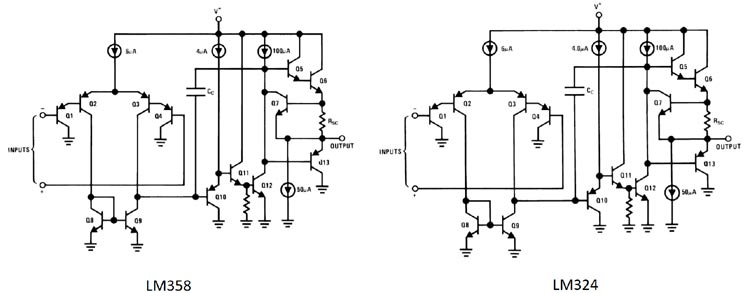Optimized at frequencies beyond traditional industry targets to support emerging applications
LM324 vs LM358 Op Amp ICs

In some cases, the manufacturers of certain ICs make them in different packages containing a different number of units. Although they might appear similar, different op-amps on the same die can have slightly different characteristics, and adding more amplifiers to the same die can make small changes in performance. In this article, we will take a look at the LM358 dual general-purpose op-amp and its quad version, the LM324.
Specifications of LM358 and LM324
Taking a look at the specifications can help us understand the differences that matter.
|
Specification |
LM358 |
LM324 |
|
Supply voltage |
32V |
32V |
|
Power dissipation |
830mW (DIP) |
1130mW (DIP) |
|
Input offset voltage |
5mV |
5mV |
|
Input offset voltage drift |
20µV/C (max.) |
30µV/C (max.) |
The only major differences in specification have to do with power dissipation – the LM358 comes in a DIP-8 package, which is smaller than the DIP-14 package that the LM324 comes in. This means that the LM324 can dissipate more power than the LM358. This might also be the cause for the larger drift in offset voltage for the LM324.
Note: More technical specifications can be found in the LM358 Datasheet and LM324 Datasheet linked at the bottom of this page.
Taking A Look at Inside Circuitry of LM358 and LM324

FIG. INTERNAL CIRCUIT DIAGRAM OF THE LM358 AND LM324
Taking a look at the internal circuit diagram, it is clear that both parts essentially have the same schematic for all amplifiers. Hence, the only possibility for errors arises from small differences in the way the semiconductors are manufactured and packaged.
Table Of Major Differences between LM358 and LM324
|
LM358 |
LM324 |
|
Two op-amps in a DIP-8 package |
Four op-amps in a DIP-14 package |
|
830mW power dissipation |
1130mW power dissipation |
Conclusion
For all intents and purposes, the amplifiers inside the LM358 and LM324 are the same, the only difference between the two being the number of amplifiers per package and the power dissipation capability.








